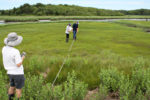Tackling saltmarsh decline with science at 11 sites around the Bay
Starting in early July, a team of researchers will be working in salt marshes around Buzzards Bay to start the next phase of a Coalition effort to better understand the causes of salt marsh loss and develop strategies to save these essential coastal habitats.
Salt marshes are important because they filter out pollution from reaching the Bay, provide habitat for wildlife, and protect homes from flooding. However, increasing stress from pollution and sea level rise is leading to the dramatic loss of many of these critical habitats, which further endangers the long-term health of the Bay.
The Coalition has committed to a portfolio of projects that are aimed at arresting the loss of salt marsh. The work includes establishing a comprehensive picture of the current health of the Bay’s salt marshes, mapping changes of the region’s salt marshes over time for historical perspective, and testing a promising approach to restoring salt marshes in danger of succumbing to sea level rise.

“Salt marshes are in decline, in part, due to pollution in the Bay’s waters, as well as sea level rise. At the same time, losing more salt marsh habitat would result in further loss in water quality,” said Alice Besterman, who is conducting the salt marsh work as the Coalition’s post-doctoral researcher. “The marshes play an important role as a filter trapping contaminants in water flowing through the habitat before it reaches the Bay.”
The Coalition aims to combat the loss of salt marsh habitat through science, much as its Baywatcher’s program has provided a foundation for efforts to improve water quality for the last 30 years.
A long-term monitoring effort undertaken in partnership with the Buzzards Bay National Estuary Program will resume, collecting current data on the current health of salt marshes from Dartmouth to Falmouth. The fieldwork involves recording detailed information on vegetation and animals found at specific locations at each of 11 salt marshes that have been selected for ongoing study.
At the same time, the Coalition will be launching an effort to test a new technique for salt marsh restoration, which is known as runneling. This technique involves creating a shallow groove in the surface of the marsh—a runnel—that will funnel seawater from where it collects to the marsh’s edge, helping to drain it. This water, collecting in many marshes because sea levels are rising faster than marshes can adapt, can kill plants in the central part of the habitat that are not adapted to sitting in salt water.
Before the tests can begin, the Coalition’s team will spend the summer establishing baseline data for the test sites. The monitoring will include vegetation, soil conditions, water levels, and other ecosystem processes. After the runnels are created, the monitoring will continue to observe whether and how this new technique contributes to strengthening the health of these salt marshes being studied.
Halting the decline of the Bay’s salt marshes not only will help efforts to improve water quality, but it will also protect critical habitat for myriad fish and shellfish species that spawn, grow and live in these areas. Coastal developments will also benefit, as marshes help to absorb the energy of ocean waves and absorb the temporary flooding caused by storm surges.
The model runneling project is a partnership involving the Coalition and the Buzzards Bay National Estuary Program, the Woods Hole Research Center, Save The Bay, the U.S. Geological Survey, and the Bristol County Mosquito Control Commission. The effort recently received a major boost in the form of a new grant from the Northeast Climate Adaptation Science Center, funding a third-year of the effort.
“We are really looking at long-term impacts with this project,” Besterman said. “The additional grant funding will give us the space to take measurements in the salt marshes through 2023, which will cover three full growing years. Being able to look at changes over that time span is critical. For example the vegetation’s response to the runneling may not become clear until the second or third growing season.”
This project is supported by Southeast New England Program (SNEP) Watershed Grants. SNEP Watershed Grants are funded by the U.S. Environmental Protection Agency (EPA) through a collaboration with Restore America’s Estuaries (RAE). For more on SNEP Watershed Grants, see www.snepgrants.org.